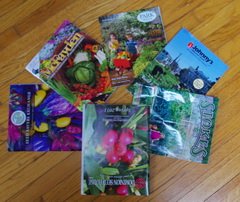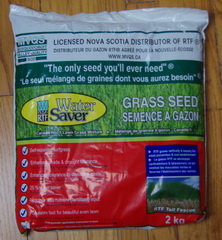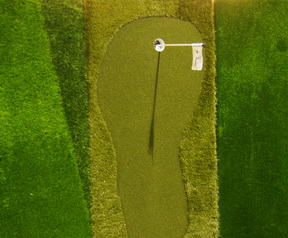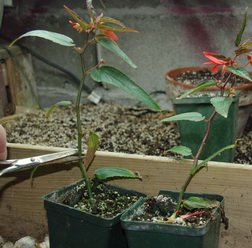


The New year has come and gone. Several grandchildren came and visited which means several Amaryllis bulbs were planted. I love using these large, almost idiot proof, bulbs to entice little people to enjoy gardening. They love mucking about in the soil at any age and the older ones take a keen interest in watching their efforts grow so quickly and then produce such huge flowers. I buy a few new varieties each year to build up my collection of these delightful flowers and am quite successful at getting them to rebloom in following years.  I am now starting my yearly fight with myself. There are several tried and true varieties of flowers and vegetables that have performed well for me for several years and then there are, all of those wonderful sounding new varieties, in the seed catalogues. I only have a certain amount of space. What to do? I read the descriptions of the new varieties several times trying to resist their siren call, realizing that if I don’t, something has to go. Each year I imagine that I can squeeze a few more things into the garden but that is not reality. Last year it was quite obvious that I had too many things growing and it became a battle for real estate and light out there, with the more vigorous plants winning and the others not performing well at all. This year has to have a more reasonable approach. I may have said that before.
I am now starting my yearly fight with myself. There are several tried and true varieties of flowers and vegetables that have performed well for me for several years and then there are, all of those wonderful sounding new varieties, in the seed catalogues. I only have a certain amount of space. What to do? I read the descriptions of the new varieties several times trying to resist their siren call, realizing that if I don’t, something has to go. Each year I imagine that I can squeeze a few more things into the garden but that is not reality. Last year it was quite obvious that I had too many things growing and it became a battle for real estate and light out there, with the more vigorous plants winning and the others not performing well at all. This year has to have a more reasonable approach. I may have said that before.One of the few bright spots for a snow bound gardener is the arrival of “show” season. There are several garden related shows to attend during the winter, depending on how far you want to travel. Those of us who live in S. Ontario, look forward to Canada Blooms in early March. It is the biggest consumer gardening show in Canada and I will be speaking at it again this year. Last week I spent a couple of days at Landscape Ontario’s huge trade show. It is definitely not a consumer show but it is filled with lots of new and interesting products that you may see in your garden centres this spring. Here, and in the next few issues of Dallying In The Dirt, I will tell you about some of the things that I found interesting.  I can only tell you to stay tuned as I try a product that I hope is going to solve one of my gardening dilemmas. RTF water saver is a new variety of grass seed. RTF is an acronym for, rhizomatus tall fescue. Tall Fescue is a drought tolerant, grass that has been around for many years and there have been several attempts to make marketable varieties but they lacked the ability to spread or fill in damaged areas. This new variety, as the name indicates, produces rhizomes; which are underground stems that help the plant to quickly spread into new or damaged areas. I have a few narrow grass pathways between my beds and most grass varieties that I have tried will not tolerate the traffic. We will seed these areas this spring and continue to report to you on the ability of this variety to withstand the traffic and to require less water while staying green through the middle of summer.
I can only tell you to stay tuned as I try a product that I hope is going to solve one of my gardening dilemmas. RTF water saver is a new variety of grass seed. RTF is an acronym for, rhizomatus tall fescue. Tall Fescue is a drought tolerant, grass that has been around for many years and there have been several attempts to make marketable varieties but they lacked the ability to spread or fill in damaged areas. This new variety, as the name indicates, produces rhizomes; which are underground stems that help the plant to quickly spread into new or damaged areas. I have a few narrow grass pathways between my beds and most grass varieties that I have tried will not tolerate the traffic. We will seed these areas this spring and continue to report to you on the ability of this variety to withstand the traffic and to require less water while staying green through the middle of summer. I was also amazed at a snowblower that was taller than me and about 3 M long. Just the thing for a suburban driveway. This is a commercial show after all. If you really don’t like maintaining your lawn then there were several booths showing a variety of plastic grass. They had fancier names for it and they had it in several textures and colours but it was still plastic grass and this gardener shudders at the thought that it might be coming more popular. It uses non-renewable resources to produce it and its ability to absorb carbon dioxide and release oxygen is minimal at best.
I was also amazed at a snowblower that was taller than me and about 3 M long. Just the thing for a suburban driveway. This is a commercial show after all. If you really don’t like maintaining your lawn then there were several booths showing a variety of plastic grass. They had fancier names for it and they had it in several textures and colours but it was still plastic grass and this gardener shudders at the thought that it might be coming more popular. It uses non-renewable resources to produce it and its ability to absorb carbon dioxide and release oxygen is minimal at best. Garden ornaments and statuary where available in every size, shape and colour that you could imagine. I admit to having a couple of such items in my garden but I am struggling to find the correct location for this bust of ??? Little Lord Fauntleroy?? More of what I discovered will be in future editions. Please advise me if you want to know the source for the statue. They also had a large selection of huge ornate planters etc.
Garden ornaments and statuary where available in every size, shape and colour that you could imagine. I admit to having a couple of such items in my garden but I am struggling to find the correct location for this bust of ??? Little Lord Fauntleroy?? More of what I discovered will be in future editions. Please advise me if you want to know the source for the statue. They also had a large selection of huge ornate planters etc.If you tend to your houseplants during the winter and want to learn more about indoor gardening, I am teaching just such a class for two Fridays in early February at the Toronto Botanical Garden. Keeping up to date on gardening activities can be followed on a more frequent basis by checking the front page of my web site, gardening-enjoyed.com. It changes every 2 or 3 days to show you what I am up to. That change only takes a few minutes, while producing Dallying is a much larger effort. Questions My newsletter subscribers get to ask me questions. Just ‘reply’ to the email newsletter. It is always interesting to read the questions; mostly to see if I actually can answer them or if I have to wade into the textbooks to research the answers. If that happens then we all learn something. 111 Trent St. W. Whitby ON L1N1L9 |
 The Amaryllis are really the start of the gardening year but in the basement, all of the cuttings that were taken from Geraniums and Begonias in September, are growing quite rapidly and it is time to make more
The Amaryllis are really the start of the gardening year but in the basement, all of the cuttings that were taken from Geraniums and Begonias in September, are growing quite rapidly and it is time to make more 